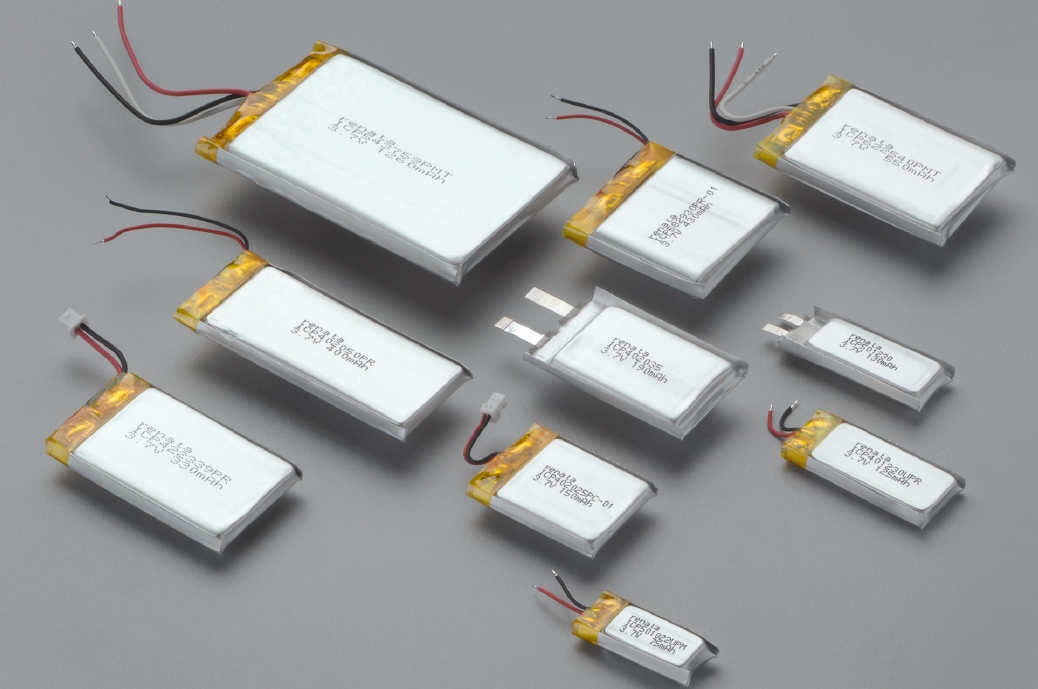
Almost all modern gadgets have one thing in common - they have a rechargeable battery. And its capacity remains one of the main criteria when choosing a device. We live in an era of mobility, and battery requirements are increasing every year.
Batteries for laptops (and many others) are made up of energy elements arranged in interconnected cells. Laptops, like most other mobile devices, work on lithium-ion or lithium-polymer batteries.
Few people think about how difficult it is to create a battery that meets the requirements of time. Today you will learn how they are produced on an industrial scale ... starting with chemical elements.
Li-ion - lithium-ion
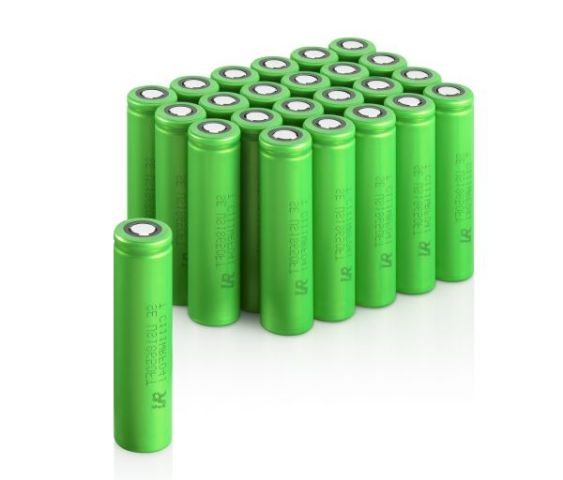
A widespread lithium-ion battery consists of electrodes (a cathode of aluminum foil and an anode of copper), separated by a porous separator soaked in liquid electrolyte. The package of electrodes is placed in a sealed enclosure, the cathodes and anodes are connected to the current collector terminals. The housing is sometimes equipped with a safety valve that relieves internal pressure during an emergency or operating condition violation.
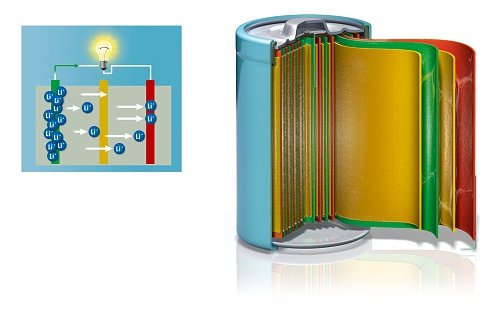 A typical lithium-ion rechargeable battery consists of a positive electrode (green), a negative electrode (red), and a separator layer (yellow) separating them. Lithium ions (Li +, blue) move from the negative electrode (anode) to the positive (cathode). During charging, the reverse process occurs, lithium ions are transferred to the anode. A source
A typical lithium-ion rechargeable battery consists of a positive electrode (green), a negative electrode (red), and a separator layer (yellow) separating them. Lithium ions (Li +, blue) move from the negative electrode (anode) to the positive (cathode). During charging, the reverse process occurs, lithium ions are transferred to the anode. A sourceThe lithium-ion battery has a high energy density, but it is quickly discharged when used in the cold and can be explosive when recharging above 4.2 V. If you pierce the lithium-ion battery and create a short circuit, it will catch fire and there will be a really strong fire that cannot be easily extinguish with ordinary fire extinguisher. That is why many of these batteries are equipped with special protection.
Li-po - lithium-polymer

Lithium-polymer battery (lithium-ion polymer battery) is an improved design of a lithium-ion battery. In such an accumulator, not a liquid, but a dry polymer material (synthetic plastic) is used as an electrolyte. Unlike Li-ion, Li-po is safer, can give strong currents and, thanks to the polymer material, it can be of any thickness and shape.
Li-po and technology

A laptop
equipped with a lithium-polymer battery supports 3 times more charging cycles (that is, it lasts 3 times longer) than a laptop with a standard lithium-ion battery.
Energy efficiency is achieved not only due to the chemical properties of the battery. If the laptop remains connected to the charge when the battery is fully charged, this can lead to a deterioration in battery performance and, accordingly, to a reduction in its service life. It can also cause the battery to swell due to internal gas accumulation caused by oxidation, and therefore deformation or damage to the laptop. Additional
software technologies allow you to set a maximum charge level of 60%, 80% or 100% to extend the battery life and reduce the likelihood of its swelling.
Laptops are also equipped with a fast charging mechanism, with which the battery charges in a few tens of minutes, a little more than half.
Li-po vs Li-ion
The positive and negative electrodes of Li-po and Li-ion have a similar chemical composition. The main difference between the two types of batteries lies in the way they are assembled. With lithium-ion technology, only a rigid metal body can be selected for the shell, while lithium-polymer technology allows the use of a soft shell for the body (plastic or aluminum foil). With a thickness of up to 3 mm, Li-po has the advantage of capacity. With a thickness of more than 3 mm, Li-ion gives a significant price advantage.
There are other types of lithium-based batteries: LiFePO4 - lithium-iron-phosphate, LiFeYPO4 - lithium-iron-yttrium-phosphate, and others. They differ in the various additives improving characteristics of the battery. However, most of the new experiments are based on the same metal, which replaced the once popular nickel-cadmium and nickel-metal hydride batteries.
Lithium
 Very light, very soft metal of silver-white color.
Very light, very soft metal of silver-white color.The first work in the field of creating a rechargeable lithium-based battery was started in 1912, but until the 1970s, experiments did not go beyond the laboratories due to lithium instability. In the 1980s, based on technologies developed at Oxford University, the first industrial lithium batteries began to appear, which quickly overheated and went down. Only in 1991, a battery was created, in which metallic lithium was replaced by a safer ionic form.
Lithium has gained deserved popularity due to its special properties. It is one of the lightest metals in the periodic table, which really helps to save large amounts of energy in a small volume and at low weight. However, the popularity of lithium today can lead to the exhaustion of this metal in the future.
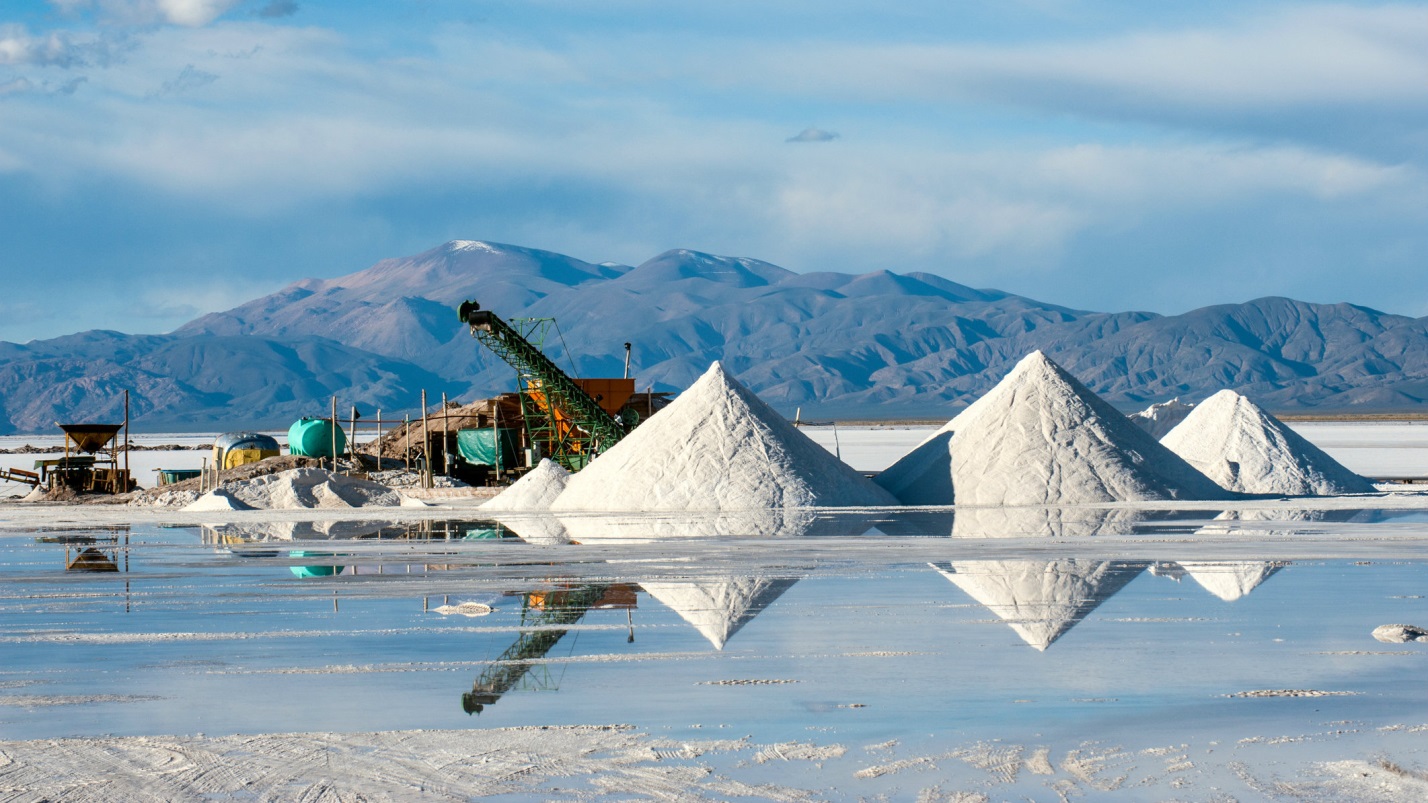
Lithium mining is a laborious process, even in those regions where there is a lot of metal. For decades, commercial lithium production has been based on mineral ore sources such as spodumene, petalite, and lepidolite. However, extraction of lithium from ore is twice as much as the cost of production from brine.
The main lithium deposits suitable for active development are in South America and China. On the territory of Russia, most of all lithium is contained in the mica accompanying the deposits of rare-earth metals. Until recently, the extraction of lithium from mica was too expensive, but in 2017, scientists of NITU “MISiS”
presented an installation that made the extraction of lithium compounds from poor ore twice as cheap.
Most lithium today is extracted from natural water lenses of salt lakes, in saturated saline solutions of which lithium chloride, potassium and sodium are concentrated. The solution is pumped out and evaporated in the sun, the mixture of salts is processed.
Lithium extraction
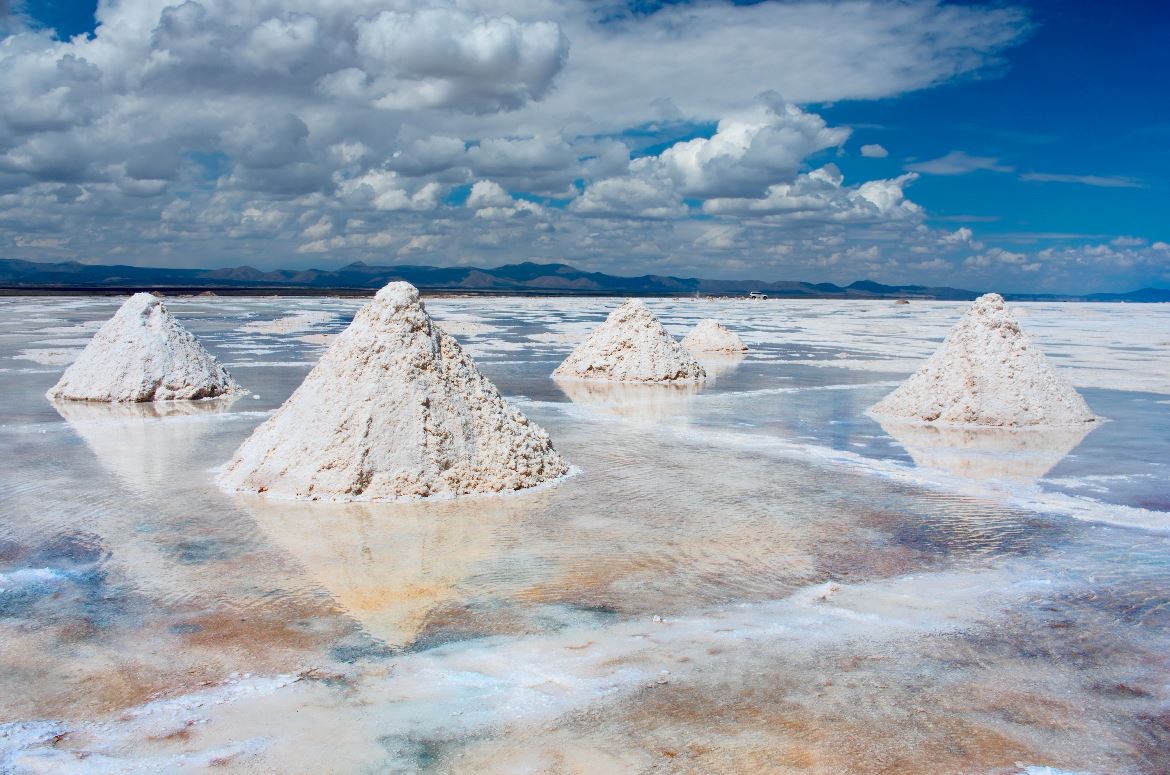 The Uyuni salt marsh contains about 100 million tons of lithium, or from 50 to 70% of its world reserves
The Uyuni salt marsh contains about 100 million tons of lithium, or from 50 to 70% of its world reserves .
The largest source of lithium is located in Bolivia - it is the Uyuni salt-marsh, a dried-up salt lake located at an altitude of about 3,650 m above sea level. It has an area of 10,588 km². The inner part is covered with a layer of salt with a thickness of 2-8 m. Lithium chloride, which is here in large quantities, is suitable for the extraction of lithium from it, and used to be used as a substitute for common salt. Eat it stopped after the discovery of toxic effects.
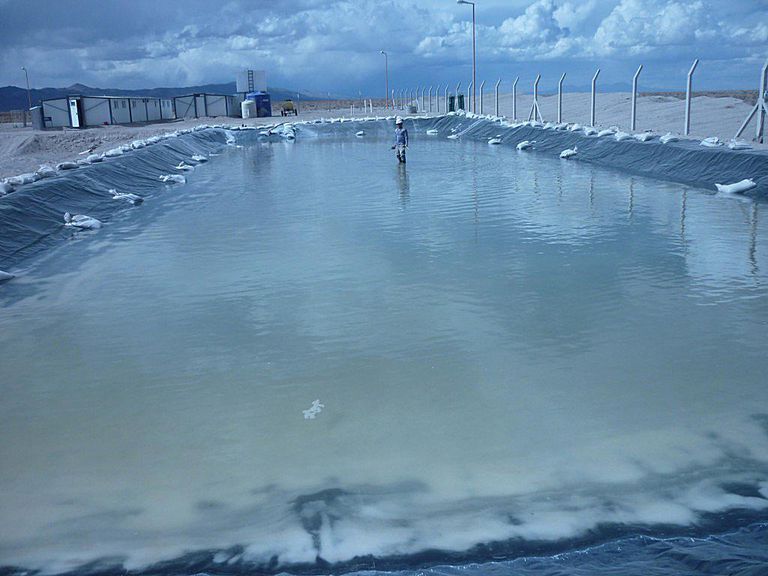 Lithium salt pond in Argentina.
Lithium salt pond in Argentina.To extract lithium, the salt solutions are first pumped to the surface in special ponds, where under the influence of the sun for several months there is a slow evaporation. When lithium chloride in evaporating ponds reaches the optimum concentration, the solution is pumped to a recovery plant, where unwanted impurities are removed from the mixture by filtration.
Lithium is converted to metal in an electrolytic cell. Lithium chloride is mixed with potassium chloride in the ratio of 55% to 45% in order to produce a molten eutectic electrolyte. Further, by electrolysis of the melt at a temperature of 600 ° C, molten lithium is obtained, which rises to the surface of the electrolyte.
Other chemical elements
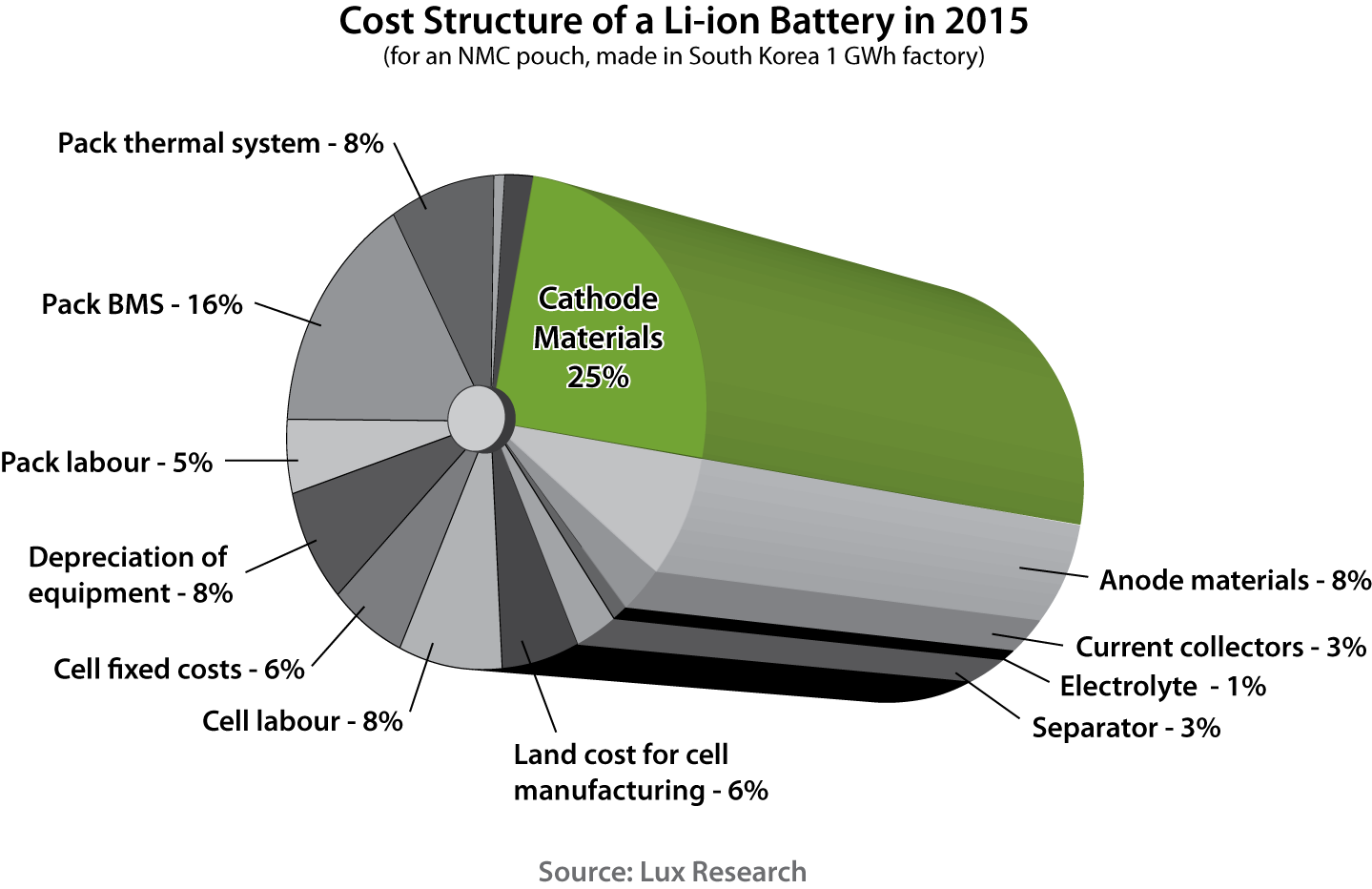 Components of the cost of Li-ion batteries.
Components of the cost of Li-ion batteries.Inside a lithium-ion battery
, several materials
can be used for cathodes. Initially, the main component of the cathode was cobalt, but it has limited availability in nature and is toxic, which is a huge disadvantage for mass production. Today, cobalt is partially replaced by nickel, as well as a mixture of cobalt, nickel and manganese.
A safe and durable battery needs a reliable electrolyte that can withstand the existing voltage and high temperatures and has a long shelf life, providing high mobility of lithium ions. Electrolyte solutions
consist of organic solvents, a salt of LiPF6 (lithium hexafluorophosphate) and various additives.
High-purity electrolyte plays a key role in the transport of positive lithium ions between the cathode and the anode. Electrolyte additives
improve stability , preventing solution degradation. The composition of electrolytes varies depending on the anodic and cathodic materials used, however, the choice of electrolyte often involves a compromise between flammability and electrochemical characteristics.
Polymer electrolytes are ion-conducting polymers. They are often mixed in composites with ceramic nanoparticles, which leads to higher conductivity and resistance to higher voltages.
In lithium-ion batteries, a variety of metallic foils — copper, nickel, or catalytic copper foil — are used as current collectors. As a rule, copper foil is placed as a negative electrode for an anode current collector, and aluminum foil is used as a positive electrode for a cathode current collector.
 The structure of the Li-po battery
The structure of the Li-po batteryThe anode consists of a mixture of graphite and lithium (it is also possible to use intermetallic compounds or silicon), while the cathode combines lithium and other metals (the materials of the cathode require extremely high purity and must be almost completely free from unwanted metallic impurities - iron, vanadium and sulfur) .
Separates the cathode from the anode separator material from polypropylene, polyethylene or other similar polymeric material. Most battery separators consist of very simple plastic films that have the correct pore size to allow ions to move while blocking other elements. In the case of a liquid electrolyte, the separator is a foamed material that is impregnated with the electrolyte and holds it in place.
Battery manufacturing process
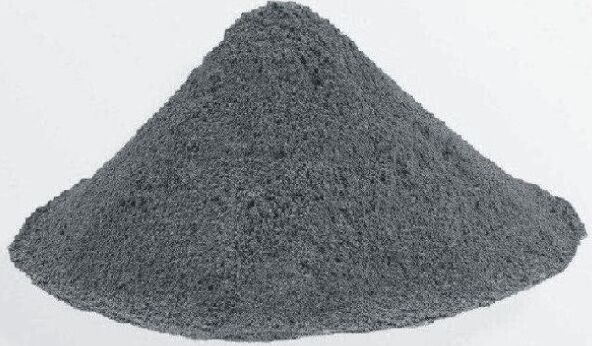
The bases for the anode and cathode are supplied to the plant as
black powder , and for the unprepared eye they are almost indistinguishable from each other. Very fine powder to achieve maximum effective surface area of the electrodes. Particle shape is also important. Smooth spherical grains with rounded edges are preferred, because sharp edges or flaky surfaces are sensitive to high electrical loads.
Anodes and cathodes in lithium batteries have the same shape and are performed by similar processes on identical equipment. But since the pollution between the anode and cathode materials will lead to the destruction of the battery, they are usually processed in different workshops to prevent materials from contacting.
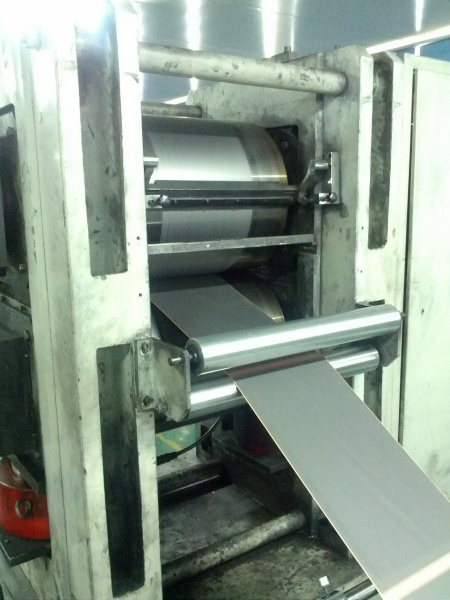
The first stage of production consists in mixing the materials of the electrodes and applying a suspension on the surface of the foil. Active electrode materials are covered on both sides with a metal foil, which acts as a current collector, conducting current inside and outside the cell. Then the foil with materials is dried, cut into narrow strips and rolled up in several layers. This requires constant monitoring, as any burrs at the edges of the foil strips can lead to internal short circuits in the cells.
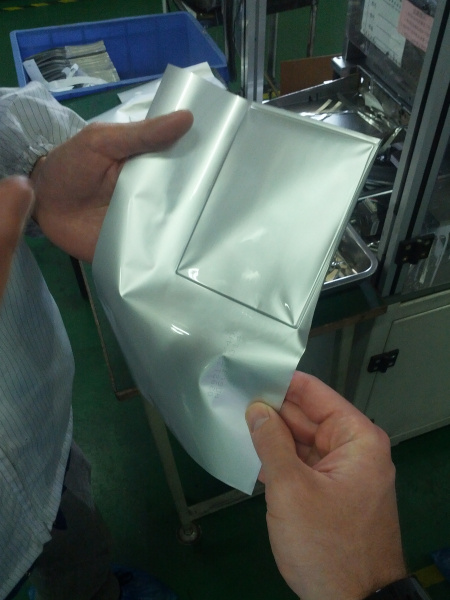
During battery assembly, the separator is clamped between the anode and the cathode. After placing the battery in the case it is filled with electrolyte and sealed. This should be done in a “dry room” as the electrolyte reacts with water. Moisture will lead to decomposition of the electrolyte with the release of toxic gases.
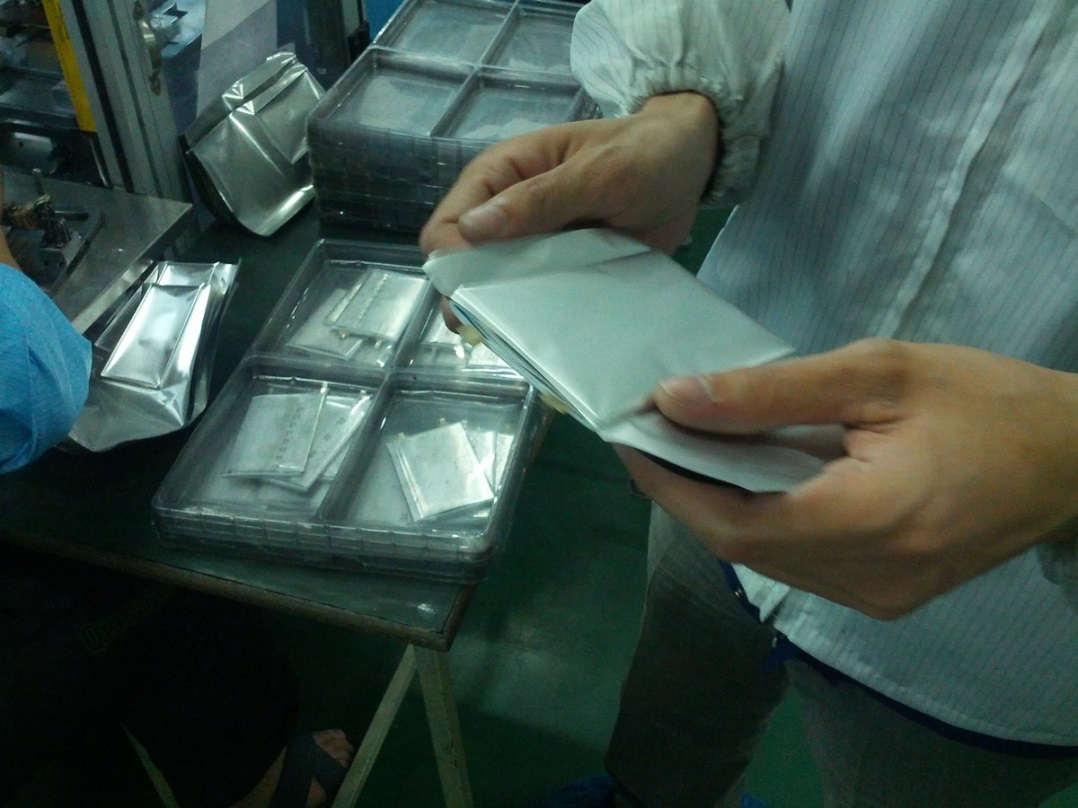 The electrodes are placed in the housing, leaving a hole for adding electrolyte /
The electrodes are placed in the housing, leaving a hole for adding electrolyte /Once the cell assembly is complete, it must go through at least one controlled charge / discharge cycle. The charging process begins with a low voltage, which gradually increases. Only after passing the test, the battery will leave the factory and go on.
* * *
In the future, of course, there will be new types of batteries. Perhaps then lithium will remain in the past. In the meantime, there are still many opportunities to improve the characteristics of existing batteries.